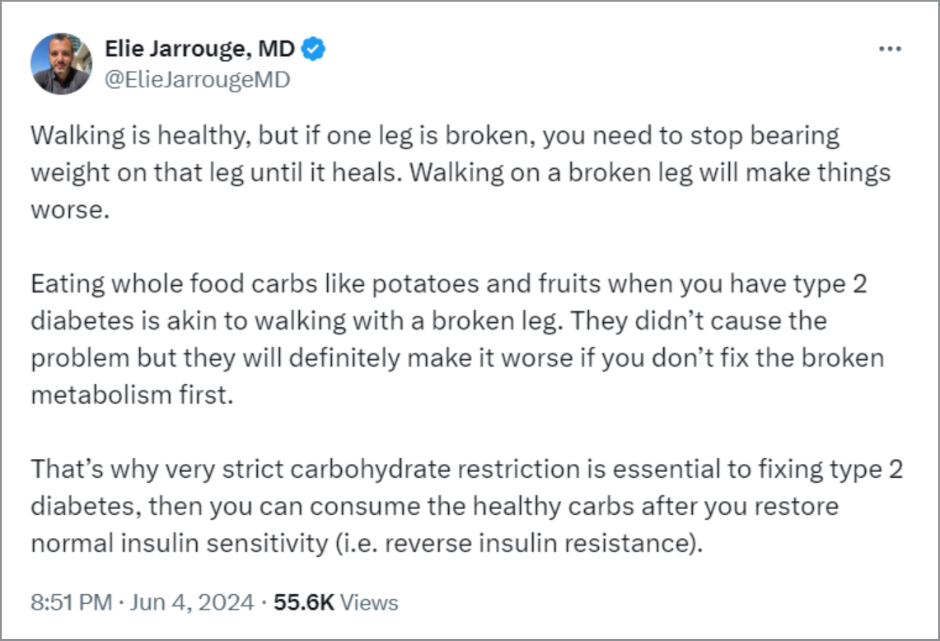If you’re serious about reclaiming your metabolic health, you should start by getting your blood sugar under control. High blood sugar indicates dysfunction in your body, and if you don’t address it quickly, it can spiral out of control.
The good news is that you can control your blood sugar for the long-term. If you have type 2 diabetes, you can even reverse your condition.
With the right exercise, a continuous glucose monitor (CGM), and whole, real food, you can keep your blood sugar well within range.
How blood sugar affects the body
The way your body handles sugar is one of the most complex facets of metabolic health.
Here are the major functions and interactions:
- Blood glucose: Another way to say ‘blood sugar.’ Excess blood glucose stores as glycogen in the muscles or fat in the body.
- Insulin: A hormone created by the pancreas that converts food into cellular energy. Insulin resistance, then, happens when your body does not respond to large amounts of insulin in the bloodstream.
- Inflammation: The body swells in response to harmful substances in the body. Excess sugar is often viewed as a ‘foreign invader,’ which causes your body to bloat or swell in order to control the threat.
I cover several other relevant terms in my metabolic health glossary.
To summarize it briefly: your body wants to turn food into glucose, then push it into your cells with insulin. When your body can’t do this, it leaves excess sugar in your bloodstream. This can damage your blood vessels, cause kidney problems, and eventually lead to heart disease.
A healthy range for blood sugar
Blood sugar is one of the ‘big five’ indicators of good metabolic health. If you’ve taken my metabolic health quiz before, you know it’s one of the first questions I ask.
Your glucose should be:
- Below 100mg/dL while fasting (when you haven’t eaten in 12 hours)
- Between 170 and 200 mg/dL immediately after eating
- Less than 140 mg/dL two hours after eating
If you exceed one or more of these limits, there’s a good chance you’re struggling with prediabetes or hyperinsulinemia.
How to lower your blood sugar
Getting your blood glucose under control is a major step in reversing metabolic syndrome.
To do this, I recommend you:
Track your blood sugar throughout the day
Most people can’t tell when their blood sugar spikes, which is why I urge patients to test, not guess.
Some people use fingerstick monitors, which aren’t bad. Others rely on continuous glucose monitors, or CGMs, to constantly track their glucose levels. Both options allow you to look for patterns after eating, track sugar spikes after mealtimes, and check your insulin sensitivity over time.
Just keep in mind you may need other blood tests to ensure you’re on the right track. I recommend three specific blood labs to keep an eye on your metabolic health.
Avoid processed food
Nearly seven out of 10 processed foods contain some added sugar, and 73% of the US food supply is ultra-processed food. If you’re already struggling with blood sugar swings, eating lots of processed food will make them harder to control.
I recommend eating whole, real foods, which include things that come from the ground or eat things that grow on the ground. This means cutting out cereal, microwave popcorn, and instant noodles and replacing them with eggs, milk, and meat.
A few guidelines as you begin:
- Shop around the outside edge of your grocery store. That’s where most of the whole, real food will be.
- Start cooking at home as much as possible. You can rest easy knowing what goes into your meals.
- If you do buy food with an ingredients list, be sure to check for hidden sugar. Even ‘healthy’ snacks like roasted almonds and seaweed could have sweeteners or syrups to broaden their appeal.
Of course, choosing whole, real food is just the first step in changing your diet. There are a few other caveats to address below.
Watch sugary fruits
Many people believe that fruit is ‘essential’ to a healthy diet. But when we realize fruits like mangoes contain more sugar than a can of Coke, we see this isn’t necessarily true.
That’s not to say fruit is worse than sugary soda — but eating large amounts of sugary fruit isn’t going to help with insulin resistance.
My good friend Dr. Elie Jarrouge likens it to walking on a broken leg. Fruit didn’t cause your metabolic dysfunction, but it certainly won’t help it heal.

Depending on where you’re at in your blood sugar journey, you can still eat fruit as a treat or dessert.
There are several fruits with lower glycemic loads:
- Blueberries
- Blackberries
- Strawberries
But remember: everyone’s body will respond somewhat differently. The only way to know how your body will react is to use a fingerstick tester or wear a continuous glucose monitor.
Limit carbohydrates
Especially during the holidays.
If you’re struggling with near-constant blood sugar spikes, excess carbs are likely a major contributor.
If you’ve been diagnosed with prediabetes or diabetes, or if you’re struggling with hyperglycemia, I highly recommend increasing your fat and protein intake. Then, cut back on the number of carbs you eat.
You can start slow by:
- Drinking one less soda or fruit juice per day
- Avoiding bread for at least one meal
- Skipping dessert at dinner
Just start with one of these recommendations and see how your blood sugar responds. As you start to see progress, you can add more health practices into your temptation bundle.
Of course, a ‘low-carb diet’ looks different for everyone, so I recommend doing your research. Many of you know that I follow a carnivore diet, which means I consume few if any carbohydrates in a day. Many of my patients follow Atkins-style or keto diets, so feel free to look around and see what best suits your body.
Exercise after meals
Your blood sugar rises naturally after eating, and more so if you’re consuming something high in carbohydrates. However, studies show that postprandial exercise (aka movement after eating) can help to reduce the severity of these spikes.
This doesn’t have to be a difficult or intensive workout. In fact, many people prefer to go on 15-minute walks.
As long as you’re moving at least two to five minutes, you can easily reduce your blood sugar levels and make your cells more receptive to insulin.
By the way: foods high in protein and fat rarely cause major blood sugar swings. Try eating steak and eggs for breakfast — it’s a great way to start the day without spiking.
Getting a handle on your blood sugar
High blood sugar is an epidemic in America. As many as 84% of people don’t even know they have it.
But if you’re eating whole, real foods and exercising after meals, it’s possible to reverse your insulin resistance and get your blood sugar back under control.
Of course, I realize it can be difficult to control your blood sugar levels if you don’t have outside support. That’s why I organized my Heart Health Hub: to help people like you plug into the ultimate support community.
